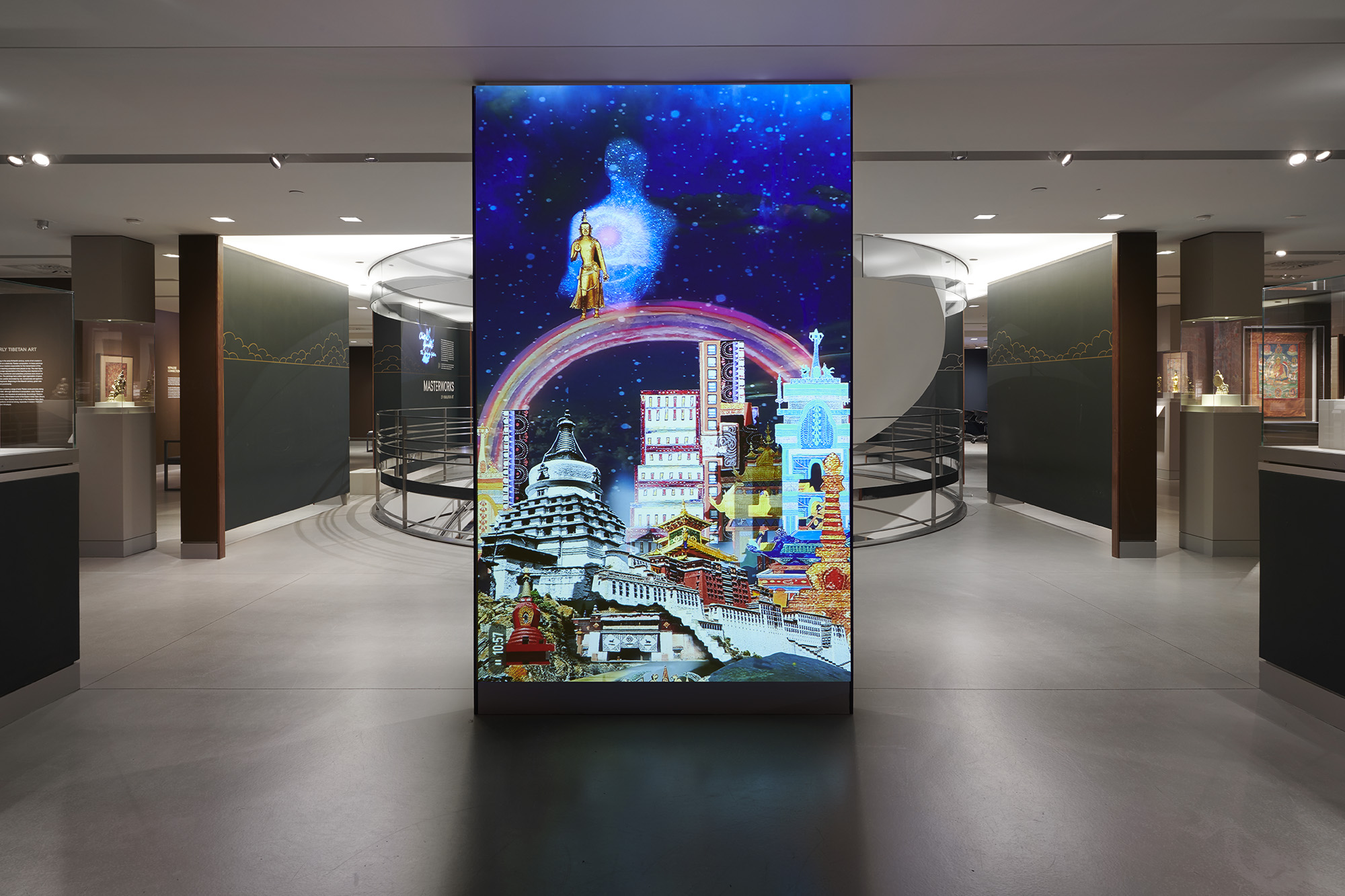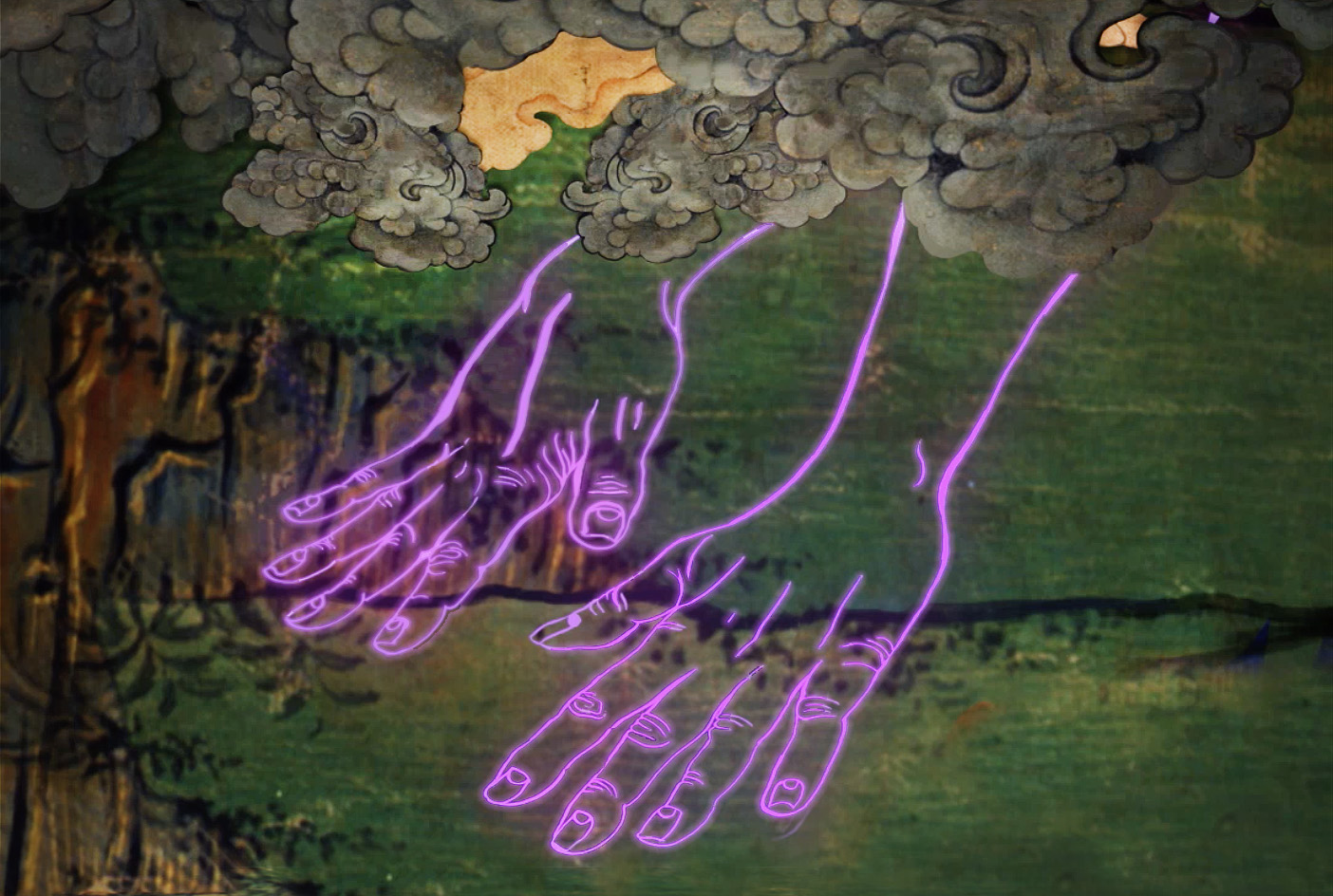Shows
Chitra Ganesh’s “The Scorpion Gesture/Face of the Future”


An animated mudra flashed across an otherwise staid gallery sign for the exhibition “Masterworks of Himalayan Art,” which featured pieces from the Rubin Museum’s permanent collection, spanning over a thousand years of history. The floating hand appeared as if it had been digitally lifted from a two-dimensional painting, before it cross-transitioned into a neon outline mimicking the same gesture. This introduction to Chitra Ganesh’s “The Scorpion Gesture,” one of two concurrent exhibitions from the museum’s newly named Future Fellow, teases the manner in which the Brooklyn artist’s works were interpolated into the museum’s galleries. Dispersed throughout two floors, the five motion-sensor activated videos played alongside, and sometimes in conjunction with, the objects on display, creating a lively dialogue between contemporaneity and tradition, while the Theatre Level, dedicated to Ganesh’s second exhibition, “Face of the Future,” held a series of paper and collage-based works that reimagined science fiction films through a non-Western lens, rendered in the style of vintage, hand-drawn movie posters.

In “Masterworks,” Himalayan religious traditions were highlighted via works like Namkhai Nyingpo Performing a Long-Life Ritual, a 19th century painting that depicts an orange-robed lama holding an arrow, symbolizing longevity, in his right hand, surrounded by other materials for the ritual. Among these items, a gold vase containing peacock plumes gives rise to a curl of smoke that swells into a cloud carrying deities and goddesses. This particular invocation, while a frozen moment in the painting, bursts into life in Ganesh’s The Messenger (2018): a flame travels up the master’s hand framed in a close-up shot clutching the decorated arrow, which is then set ablaze. The animated sequence also makes visible every minute detail, from the emerald luminescence of the feathers to the goddesses’ coy smiles as they sway from side to side. By illustrating such moments, the animation offers a clear interpretation of the ritual itself and how it was intended to manifest, while enhancing the splendor of the original work.
Though Ganesh takes care to faithfully adapt many of the source works in The Messenger, in other instances, she creates a hybrid narrative. Adventures of the White Beryl (2018) abstracts Tibetan divination, as zodiac animals and symbols of Chinese numerology fall and swirl around the silhouette of female figures performing yogic poses. Meanwhile, Rainbow Body (2018) departs from the story of Padmasambhava, also known as the Second Buddha. Told through the imagined perspective of his consort, the video depicts princess Mandarava waking from her sleep. Her likeness, outlined in glowing magenta, is rendered in the vein of a comic book heroine, while a photograph of her namesake flower with digitally painted scarlet petals hangs before her. This layering of analog and digital textures can also be seen in the faded, floral pattern of the canvas-like background. Given that Mandarava rejected marriage in order to pursue her spiritual calling of practicing dharma and teaching other women, her tale seems especially primed for a feminist, superhero portrayal. As a nod to the movies, the illustration of two people holding up what look like 3D glasses while viewing these foundational Buddhist figures suggests the artist’s desire to reframe them as mythic characters relevant for our time.
Ganesh’s interest in cinema, particularly its capabilities as a vehicle for re-envisioning alternative narratives, can also be found in the accompanying exhibition, “Face of the Future.” The same illustrated pair of observers from Rainbow Body reappear in the paper collage Dakini Eclipse (2018), where we see that their protective eyewear is for watching spirits dance across a phantasmagorical sky. In addition to the artist’s series of collages and works on paper, seven other artists were invited by Ganesh to contribute their own posters for invented movies. Maia Cruz Palileo’s Aswang (2017) explores the Filipino folklore of the eponymous shapeshifting creature, while Anuj Shrestha’s This Carceral Earth (2017) conveys the dystopian premise of a mother and daughter running to escape from an immigration border agent and fleet of aerial drones.
An apocalyptic overtone likewise permeates Ganesh’s Silhouette in the Graveyard (2018), which uses a mix of mythological and real imagery to reflect our present-day environmental and social crises. Serving as a backdrop to a gilt statue of Maitreya, the Future Buddha from the late 18th to early 19th century, the animations of skeletons raining down and media documenting political unrest align with the prophecy of the Future Buddha’s arrival, hailing the end times. In Metropolis (2018), the artist projects a more optimistic vision, in which a giant statue of Maitreya stands amid skyscrapers and temples. This take on Asian futurism reveals Maitreya transforming into a female warrior, who may save the world yet.
Just as cultures are not fixed, “The Scorpion Gesture” abounds in color and light, evoking a digital aesthetic even as the animations incorporate older examples of Buddhist art that have proliferated across geographies and time. Although the juxtaposing of traditional art objects with contemporary works is nothing new, Ganesh thoughtfully threads the past into the future by building upon artistic practices that have historically been excluded from Western conceptions of modernity. In this way, her work provides not just an alternative but also a restorative way forward.
Mimi Wong is a New York desk editor of ArtAsiaPacific.
Chitra Ganesh’s “The Scorpion Gesture” is on view at the Rubin Museum of Art, New York, until January 7, 2019, while “Face of the Future” is on view until November 4, 2018.







